2008 AUDI TT ROADSTER belt
[x] Cancel search: beltPage 157 of 316
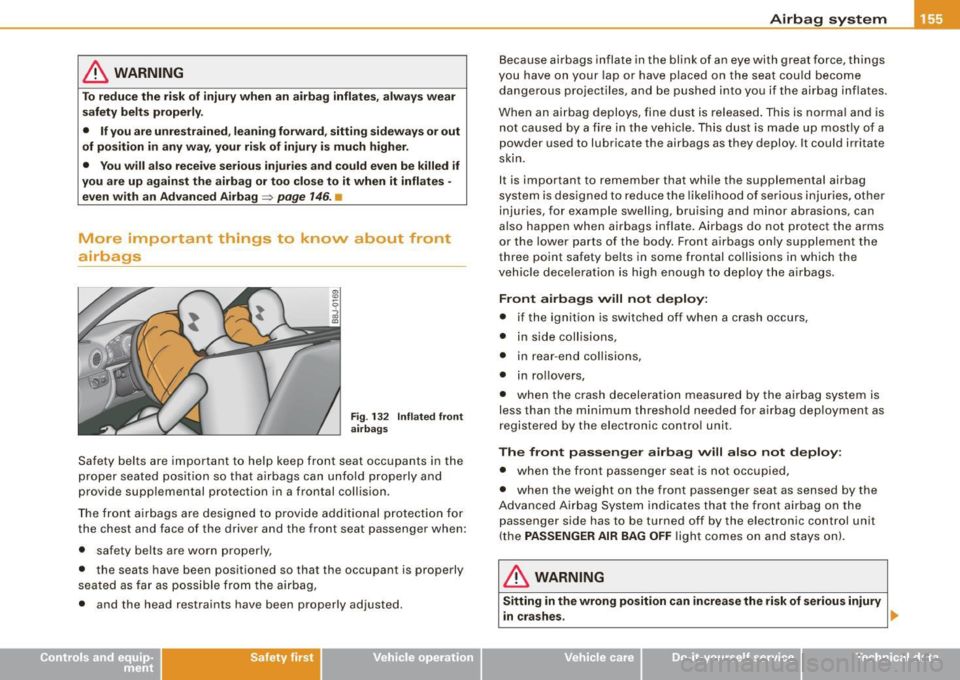
& WARNING
To reduce the risk of injury when an airbag inflates, always wear
safety belts properly.
• If you are unrestrained , leaning forward , sitting sideways or out
of position in any way, your risk of injury is much higher.
• You will also receive serious injuries and could even be killed if
you are up against the airbag or too close to it when it inflates ·
even with an Advanced Airbag~
page 146. •
More important things to know about front
airbags
Fig . 132 Inflate d front
airbags
Safety belts are important to help keep front seat occupants in the
proper seated posit ion so that airbags can unfold properly and
provide supp lemental protection in a frontal collision.
The front airbags are designed to provide additional protection for
the chest and face of the driver and the front seat passenger when :
• safety belts are worn properly,
• the seats have been positioned so that the occupant is properly
seated as far as possible from the air bag,
• and the head restraints have been properly adjusted .
Safety first
Airbag system
Because airbags inflate in the blink of an eye with great force, things
you have on your lap or have placed on the seat could become
dangerous projectiles, and be pushed into you if the airbag inflates .
When an airbag deploys, fine dust is released . This is norma l and is
not caused by a fire in the vehicle. This dust is made up mostly of a
powder used to lubricate the airbags as they deploy. It could irritate
skin.
It is important to remember that while the supplemental airbag
system is designed to reduce the likel ihood of serious injuries, other
injuries, for example swelling, bruising and minor abrasions , can
also happen when airbags inflate. Airbags do not protect the arms
or the lower parts of the body. Front airbags only supplement the
three point safety be lts in some frontal collisions in which the
vehic le deceleration is high enough to dep loy the a irbags.
Front airbags will not deploy:
• if the ignition is switched off when a crash occurs,
• in side collisions,
• in rear -end collisions,
• in rollovers,
• when the crash deceleration measured by the airbag system is
less than the minimum threshold needed for airbag deployment as
registered by the electronic control unit.
The front passenger airbag will also not deploy:
• when the front passenger seat is not occupied,
• when the weight on the front passenger seat as sensed by the
Advanced Airbag System indicates that the front airbag on the
passenger side has to be turned off by the electronic control unit
(the
PASSENGER AIR BAG OFF light comes on and stays onl.
& WARNING
Sitting in the wrong position can increase the risk of serious injury
in cras hes. .,,_
Vehicle care
I I irechnical data
Page 158 of 316
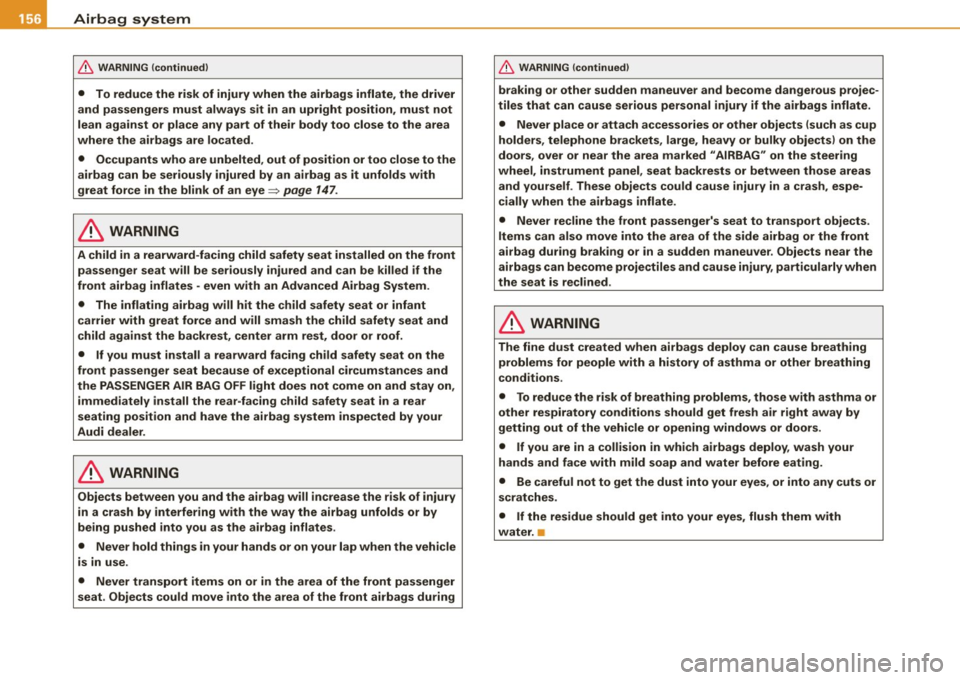
-Airbag system ----=---'---------------------------------------------
& WARNING (continued)
• To reduce the risk of injury when the airbags inflate, the driver
and passengers must always sit in an upright position, must not
lean against or place any part of their body too close to the area
where the airbags are located .
• Occupants who are unbelted, out of position or too close to the
airbag can be seriously injured by an airbag as it unfolds with
great force in the blink of an eye~ page
147.
& WARNING
A child in a rearward -facing child safety seat installed on the front
passenger seat will be seriously injured and can be killed if the
front airbag inflates -even with an Advanced Airbag System .
• The inflating airbag will hit the child safety seat or infant
carrier with great force and will smash the child safety seat and
child against the backrest, center arm rest, door or roof.
• If you must install a rearward facing child safety seat on the
front passenger seat because of exceptional circumstances and
the PASSENGER AIR BAG OFF light does not come on and stay on ,
immediately install the rear -facing child safety seat in a rear
seating position and have the airbag system inspected by your
Audi dealer .
& WARNING
Objects between you and the airbag will increase the risk of injury
in a crash by interfering with the way the airbag unfolds or by
being pushed into you as the airbag inflates .
• Never hold things in your hands or on your lap when the vehicle
is in use .
• Never transport items on or in the area of the front passenger
seat . Objects could move into the area of the front airbags during
& WARNING (continued)
braking or other sudden maneuver and become dangerous projec
tiles that can cause serious personal injury if the airbags inflate.
• Never place or attach accessories or other objects (such as cup
holders, telephone brackets, large , heavy or bulky objects) on the
doors , over or near the area marked "AIRBAG" on the steering
wheel, instrument panel , seat backrests or between those areas
and yourself . These objects could cause injury in a crash, espe
cially when the airbags inflate .
• Never recline the front passenger's seat to transport objects .
Items can also move into the area of the side airbag or the front
airbag during braking or in a sudden maneuver . Objects near the
airbags can become projectiles and cause injury, particularly when
the seat is reclined.
& WARNING
The fine dust created when airbags deploy can cause breathing
problems for people with a history of asthma or other breathing
conditions.
• To reduce the risk of breathing problems , those with asthma or
other respiratory conditions should get fresh air right away by
getting out of the vehicle or opening windows or doors .
• If you are in a collision in which airbags deploy, wash your
hands and face with mild soap and water before eating .
• Be careful not to get the dust into your eyes, or into any cuts or
scratches .
• If the residue should get into your eyes , flush them with
water. •
Page 160 of 316

___ A_ ir_ b_ a-g _ s_y _s_ t_ e_ m _________________________________________________ _
• a car bed has been installed on the front seat, or
• a rearward-facing child restraint has been installed on the front
passengerseat,or
• a forward-facing child restraint has been insta lled on the front
passenger seat, or
• the weight registered on the front passenger seat is equal to or
less than the combined weight of a typical 1 year -old restrained in
one of the rear-facing or forward-facing infant restraints listed in Federal Motor Vehicle Safety Standard 208 with which the Advanced
Airbag Sys tem in your vehicle was certified.
If the front passenger seat is not occupied, the front airbag wi ll not
deploy, and the
P ASS ENGER AIR B AG OFF light will stay on. Never
install a rearward -facing child restraint on the front passenger seat,
the safest place for a chi ld in any kind of child restraint is at one of
the seating positions on the rear seat=>
page 147, "Child restraints
on the front seat -some important things to know" and=>
page 168,
"Chi ld Safety" .
If the PA SS ENG ER A IR BAG OFF l ight com es on when one of the
conditions listed above is met, be sure to check the light regularly
to make certain that the
P ASSE NG ER AIR BAG OFF light stays on
continuously whenever the ignition is on. If the
PASSENGER AIR
B AG OFF
light does not appear and not stay on all the time, stop as
soon as it is safe to do so and
• reactivate the system by turning the ignition off and then turning
it on again;
• remove and re install the child restraint. Make sure that the chi ld
restraint is properly insta lled and that the safety belt for the front
passenger seat has been correct ly routed around the ch ild restraint
as described in the child restraint manufacturer's instructions;
• make sure that the convertible locking feature on the safety belt
for the front passenger seat has been activated and that the safety
belt has been pulled tight. The be lt must not be loose or have loops
of slack so that the sensor below the safety belt latch on the seat can
do its job=>
page 177 .
• make sure that things that may increase the weight of the child
and child safety seat are not being t ransported on the front
passenger seat;
• make sure that the safety belt tension sensor is no t blocked.
Shake the safety belt latch on the front passenger seat back and
forth;
• If a strap or tether is being used to tie the chi ld safety seat to the
front passenger seat, make sure that it is no t so tigh t that it causes
the weight -sensing mat to measure more weight than is actually on
t he seat .
If the PA SSEN GER AIR BAG OFF lig ht still doe s no t c om e on and does
not stay on continuously (when the ignition is switched on),
• t ake the child restraint off the front passenger seat and install it
proper ly at one of the rear seat positions. Have the airbag system
inspected by your Audi dealer immediately.
• move the child to a rear seat position and make sure that the
child is properly restrained in a child restra int that is appropriate for
its size and age .
T he
PASSENGER AIR BAG OFF light shou ld NOT come on when the
ignition is on and an adult is sitting in a proper seating position on
the front passenger seat . If the
PASSENGER AIR BAG O FF light
comes on and stays on or flashes for about 5 seconds wh ile driving,
under these circumstances, make sure that:
• the adu lt on the front passenger seat is properly seated on the
center of the seat cushion with his or her back up against the back
rest and the backrest is not reclined=>
page 130, "Proper occupant
seating positions",
• t he adu lt is not taking weight off the seat by holding on to the
passenger assist handle above the front passenger door or
supporting their weight on the armrest,
• the safety belt is being proper ly worn and that there is not a lot
of slack in the safety belt webbing,
• accessory seat covers or cushions or other things that may cause
an incorrect reading or impress ion on the weight-sensing mat ...
Page 161 of 316

__________________________________________________ A_ i_ r _b _a...; g::- s_ y=--- s_t _e _m __ lffl!III
under the upho lstery of the seat have been removed from th e front
p assenge r sea t,
• a safety belt extender has not been left in the safety be lt latch for
the fr ont pass enge r se at .
I n addition to the PASSENGER AIR BAG OFF l ight in the center of the
instrument pane l, the message PASSENGER AIR BAG OFF or
PASSENGER AIR BAG ON will br iefly appear in the instrument c luster
display . Thi s is to inform the drive r of the current front passenger
a ir b ag status .•
Important safety instructions on monitoring
the Advanced Airbag System
& WARNING
An airbag system that is not functioning prope rly cannot prov ide
supplemental protection in a frontal crash.
• If the airbag ind icator light comes on , it means that there may
be something wrong with the Advanced Airbag System . It is
possible that the airbag will inflate when it is not supposed to , or
will not inflate when it should.
• Have the airbag system inspected immediately by your Audi
dealer.
& WARNING
If the front airbag inflates , a child without a child restraint, in a
rearward-facing child safety se at or in a forward-facing child
restraint that has not been properly installed will be seriously
injured and can be killed.
• Even though your vehicle is equipped with an Advanced Airbag
System , make certain that all ch ildren , especially 12 years and
younger, always ride on the back seat properly restrained for their age and size .
Controls and equip ment Safety first
Vehicle operation
& WARNING (continued )
• If you must in stall a rearward-facing child safety seat on the
front passenger seat because of exceptional circumstances and
the PASSENGER AIR BAG OFF light does not appear and stay on ,
immediately install the rear -facing child safety seat in a rear
seating posit ion and have the airbag system inspected by your
Audi dealer .
• A tight tether or other strap on a rearward-fa cing child restraint
attached to the front passenger seat can put too much pressure
on the weight-sensing mat in the seat and reg ister more weight
than is actually on the seat. The heavier weight registered can make the system work as though an adult were on the seat and
deploy the Advanced Airbag when it must be suppressed causing
serious or even fatal injury to the child .
• If, in exceptional circumstances, you must in stall a forward
fac ing child restra int on the front passenger seat , always move the
seat into its rearmost position in the seat's fore and aft adjust
ment range , as far away from the airbag as possible. The backrest
must be adjusted to an upright position . Make sure that the
PASSENGER AIR BAG OFF light comes on and stays on all the time
whenever the ignition is switched on .
& WARNING
• If the PASSENGER AIR BAG OFF light does not go out when an
adult is sitting on the front passenger seat after taking the steps
described above, have the airbag system inspected by your Audi
dealer before transporting anyone on the front passenger seat .
[ i ] Tips
I f the wei ght -sens ing mat in the front passenger seat detects an
empty seat, t he fron t airbag o n the pa ssenge r sid e wil l be tu rne d
o ff , and PASSENGER AIR BAG OFF will stay on .•
Vehicle care Do-it-yourself service Technical data
Page 163 of 316

increase the force levels measured by the sensors and ma ke the
a irbag sy ste m d eploy in crashes in which it wou ld not deploy if the
changes had no t been made . Other kinds of changes may reduce
the force levels measured by the sensors and prevent the airbag
from deploying when it should.
The sensors in the safety belt buckle for the driver and front
passenger seat te ll the electronic control module i f the safety belt is
latched or not. If the safety belt is being used, the front airbag will
deploy at a sligh tly h igher rate of vehic le d ece leration than if the
safety belt is not being used. Therefore , in a particular co llision , it is
possible that an ai rbag will not deploy at a seating position where
the safety belt is being used but will inflate at the posi tion where the
safety belt is not being used . It is important tha t nothing interfere
with the safety belt buckles so t hat the sensors can send the co rrect
information about safe ty belt use to the elec tronic control unit.
& WARNING
Changing the vehicle's suspen sion including use of unapproved
tire -rim combinations can change Advan ced Airbag performan ce
and in crease the risk of serious personal injury in a cra sh.
• Never in stall su spen sion compone nts that do not have the
same performance characteristics as the components originally
in stalled on your vehi cle.
• Never use tire -rim combination s that have not been approved
by Audi.
& WARNING
Items stored between the safety belt bu ckle and the center
console can cau se the sen so rs in the buckle to send the wrong
inform ation to the ele ctron ic control module and prevent the
Advanced Airbag System from working properly .
• Always make sure that nothing can interfere with th e safety
belt buckle s and that they are not obstructed.
Safety first
Airbag sy ste m
ffi For the sake of the environment
Undeployed airbag modu les and pretensioners might be classified
as Perchlorate Material -specia l handling may apply, see
www.dtsc .ca.gov/hazardouswaste/perchlorate. When the vehicle or
parts of the restraint system including airbag modules safety belts
with prete nsioners are scrapped, all appl icable laws and regu la
tions must be observed . Your au thori zed Audi dealer is familiar wi th
t hese requirements a nd we rec ommend that y ou have your dea ler
perform this service for you. •
Knee airbags
Description of knee airbags
The air bag system can pr ovide supplemen tal pr otec tio n
to pro perly restrained fron t seat occupants.
Fi g. 13 4 D rive r's
airba g
The ai rbag for the driver is located in the instrument panel under
neath the steering wheel:=:, fig. 134 , the airbag for the passenger is
at about the same height in the instrum ent panel underneath the
glove compartment.
T he knee airbag offers add itional protection to the driver 's and
p assenger 's knees and upper and lower thigh areas as a supple -
ment to the safety belts . •
Vehicle care I I irechnical data
Page 164 of 316
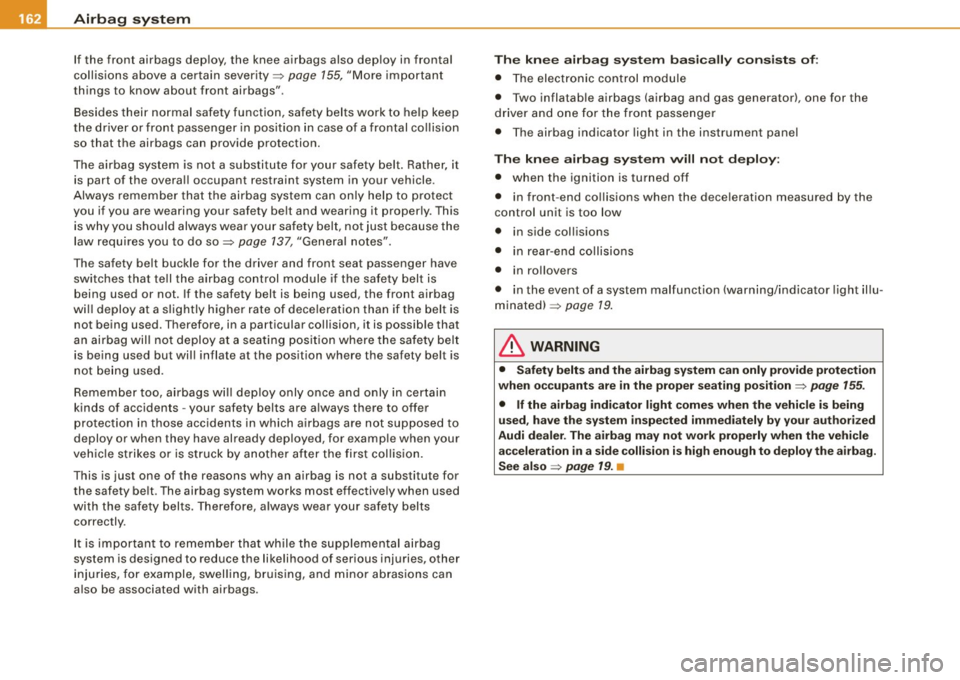
___ A_ ir_ b_ a-g _ s_y _s_ t_ e_ m _________________________________________________ _
If the front airbags deploy, the knee airbags also deploy in frontal
collisions above a certain severity=:>
page 155, "More important
things to know about front airbags".
Besides their normal safety function, safety belts work to help keep
the driver or front passenger in position in case of a frontal collision
so that the airbags can provide protection.
The airbag system is not a substitute for your safety belt. Rather, it
is part of the overall occupant restraint system in your vehicle .
Always remember that the airbag system can only help to protect
you if you are wearing your safety belt and wearing it properly. This
is why you should always wear your safety belt, not just because the
law requires you to do so=:>
page 137, "Gene ral notes" .
The safety belt buckle for the driver and front seat passenger have
switches that tell the airbag control module if the safety belt is
being used or not. If the safety belt is being used, the front airbag
will deploy at a slightly higher rate of deceleration than if the belt is
not being used. Therefore, in a particular collision, it is possible that
an airbag will not deploy at a seating position where the safety belt
is being used but will inflate at the position where the safety belt is
not being used .
Remember too, airbags will deploy only once and only in certain
kinds of accidents -your safety belts are always there to offer
protection in those accidents in which airbags are not supposed to
deploy or when they have already deployed, for example when your
vehicle strikes or is struck by another after the first collision.
This is just one of the reasons why an airbag is not a substitute for
the safety belt . The airbag system works most effectively when used
with the safety belts. Therefore, always wear your safety belts
correctly.
It is important to remember that while the supplemental airbag
system is designed to reduce the likelihood of serious injuries, other
injuries, for example, swelling, bruising, and minor abrasions can
also be associated with airbags . The knee airbag system basically consists of:
• The electronic control module
• Two inflatable airbags (airbag and gas generator), one for the
driver and one for the front passenger
• Th e airbag indicator light in the instrument panel
The knee airbag system will not deploy:
• when the ignition is turned off
• in front-end collisions when the deceleration measured by the
control unit is too low
• in side collisions
• in rear-end collisions
• in rollovers
• in the event of a system malfunction (warning/indicator light illu
minated) =:>
page 19.
&, WARNING
• Safety belts and the airbag system can only provide protection
when occupants are in the proper seating position=:>
page 155.
• If the airbag indicator light comes when the vehicle is being
used, have the system inspected immediately by your authorized
Audi dealer. The airbag may not work properly when the vehicle
acceleration in a side collision is high enough to deploy the airbag.
See also =:>
page 19. •
Page 165 of 316
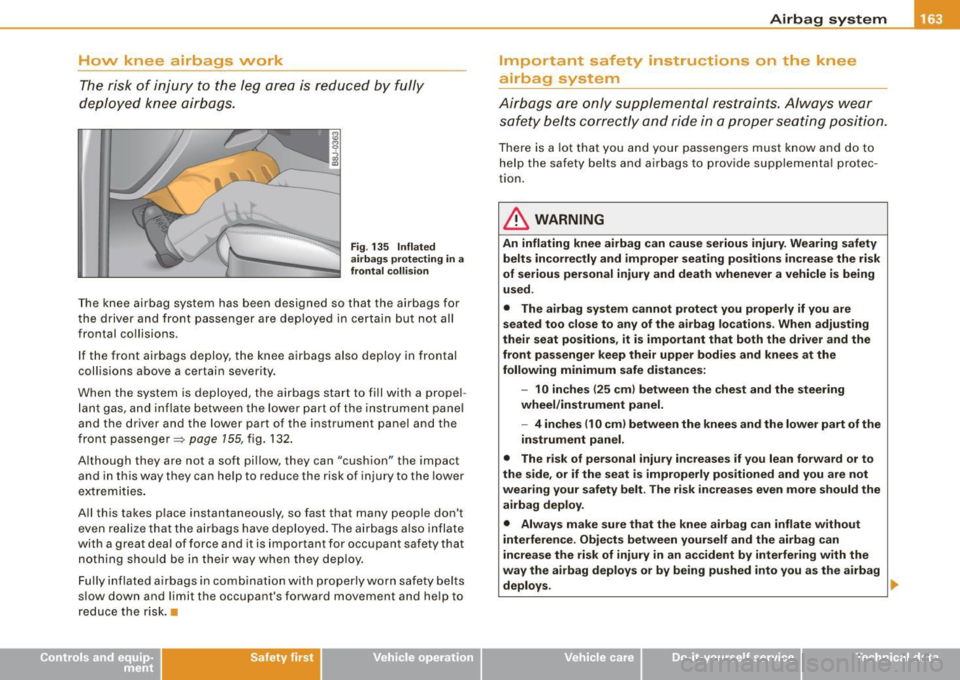
How knee airbags work
The risk of injury to the leg area is reduced by fully
deployed knee airbags.
F ig . 13 5 Infla te d
a ir b ags protect ing i n a
fr ont al co llisio n
The knee airbag system has been designed so that the airbags for
the driver and front passenger are deployed in certain but not all
frontal co llisions .
I f the front airbags deploy, the knee airbags also deploy in frontal
col lisions above a certain severity.
When the system is deployed, the airbags start to fill with a propel
lant gas, and inflate between the lower part of the instrument panel
and the driver and the lower part of the instrument panel and the
front passenger ~
page 155, fig. 132 .
Although they are not a soft pillow, they can "cushion" the impact and in this way they can help to reduce the risk of injury to the lower
extremities .
All this takes place instantaneously, so fast that many people don 't
even reali ze that the a irbags have deployed. The airbags a lso inflate
with a great deal of force and it is important for occupant safety that
nothing should be in their way when they dep loy.
Ful ly inflated airbags in combination with properly worn safety belts
s low down and limit the occupant's forward movement and he lp to
reduce the risk. •
Safety first
Airbag sy ste m
Important safety Instructions on the knee
airbag system
Airbags are only supplemental restraints. Always wear
safety belts correctly and ride in a proper seating position.
There is a lot that you and you r passengers must k now and do to
help the safety belts and airbags to provide supplemental protec
tion.
& WARNING
An inflating knee airbag can cau se se riou s inju ry . We aring safety
belt s inc orrectl y and improper seat ing po sitio ns incre as e th e risk
of seriou s pers on al injur y and death whenever a vehi cle i s be ing
u sed .
• The airbag sy stem cannot p rotect you properly if you ar e
s eat ed too clo se t o any of the a irbag l ocation s. When adju sting
their seat position s, it is important that both the driver and the
fro nt pass e nger ke ep thei r upper bod ies and knee s at the
following minimum safe di sta nces:
- 10 in che s (25 cm ) betwe en the che st and the ste ering
whee l/in strument pan el.
- 4 in ches (1
O c m ) between the knee s and the lo wer part of the
in strum ent panel .
• The r isk of per sonal injur y in crea ses if you le an forw ard or t o
t he side, or if the seat i s improperly po sitioned an d you are not
w ea ring your safet y belt . The r is k i ncreases even more should the
airbag deplo y.
• Alway s m ake su re that the knee airb ag can inf late witho ut
interferen ce. Obje cts betwe en your self and the airba g can
in crease the ris k of inju ry in an a ccident b y inte rferi ng w ith the
wa y th e airbag deploy s or b y being pushed into you a s the airbag
deploy s. •
Vehicle care I I irechnical data
Page 166 of 316
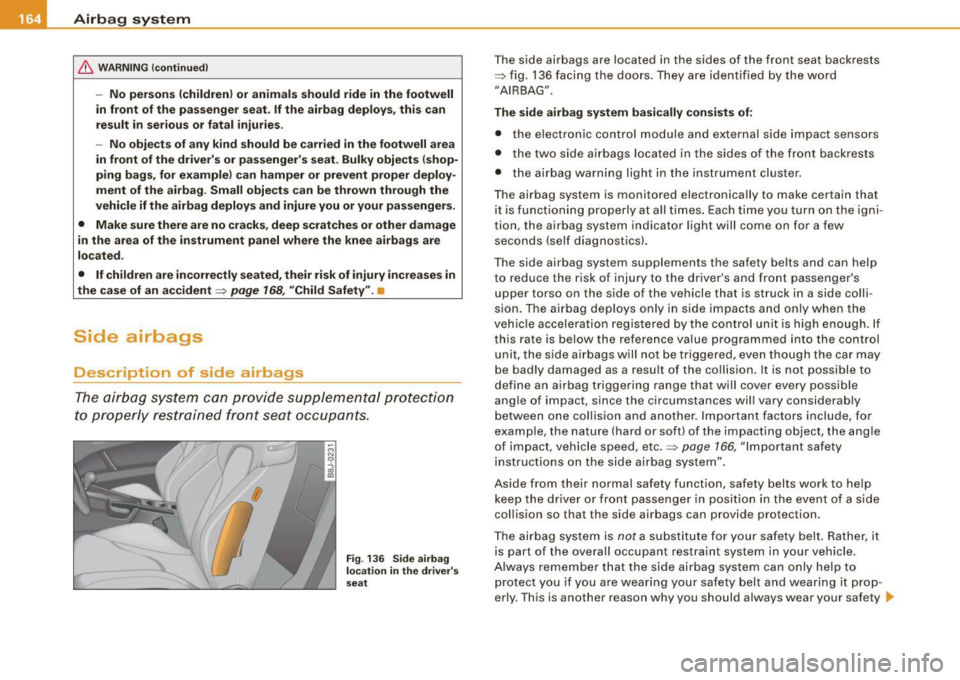
__ .....:.A..:..::..:. ir-=b :....:a=- g=- s= y-=s -=t -=e -=m.;._;_ ________________________________________________ _
& WARNING (con tinued )
-No persons (children ) or animals should ride in the footwell
in front of t he passenger s eat . If the airbag deploy s, thi s can
result in serious or fatal injuries .
- No objects of any kind should be carried in the footwell area
in front of the driver's or pa ssenger' s seat. Bulky objects (shop
ping bag s, for example ) can hamper or prevent p roper deploy
ment of the airbag . Small objects can be thrown through the
vehicle if the airbag deploys and injure you or your passenger s.
• Make sure there are no cra cks , deep scratches or other damage
in the area of the in strument panel where the knee airbags are
located .
• If ch ildren are incorrectly seated , their risk of injury increases in
the case of an accident =>
page 168, "Child Safety". •
Side airbags
Description of side airbags
The air ba g s ystem c an pro vid e sup plemen tal p ro tection
to p rope rly re straine d front seat occup ants.
Fig . 13 6 Side airbag
locat ion in the driver 's
seat
T he side airbags are located in the sides of the front seat backrests
=> fig . 136 facing the do ors. T hey ar e id en tified by the word
"AIRBAG ".
The side airbag system basically consists of :
• the e lec tro nic c ontrol m odule an d ex ternal sid e im pact sens ors
• the two side airbags located in the sides of the front backrests
• the airbag war ning light in the instrument clus ter .
T he airbag system is monitored electronicall y to make certain that
it is functioni ng properly at all times . Each time you turn on the igni
tion, the airbag system indicator light will come on for a few
se co nds (self diag nostics).
The side airbag system supplements the safety belts and can help
to reduce the risk of injury to the drive r's and fr ont passenger's
upper torso on the side of the vehicle that is struck in a side co lli
s ion. The ai rbag deploys only in side impacts and only when the
vehic le acc ele ration re gis te red by the control unit is high eno ugh . If
this rate is below the refe rence va lue programmed into the control
unit, the s ide airbags will no t be tr iggered, ev en thoug h the car may
be badly damaged as a resu lt of the co llision. It is not possible to
de fin e an ai rb a g trigge ring r ange t hat wi ll cov er ev er y possible
angle of impact , since the circumstances will vary considerab ly
bet ween one collision a nd an othe r. Importa nt fac tors include, fo r
example, the na ture (hard or soft) of the impacting object, the ang le
o f im pact, vehicle speed , et c.
=> p age 166, "Importan t safety
i nstructions on th e side airba g sys tem".
Aside from their normal safety function, safety belts wo rk to h elp
ke ep the drive r or front passenger i n pos ition i n th e ev ent o f a side
col lision so that the side ai rbags can provide pro tec tion .
T he airbag system is
not a su bstit ute for y our sa fety belt . Ra the r, it
is part of the overa ll occupa nt restrain t system in your vehicl e.
A lwa ys reme mber tha t the side ai rbag sys tem can only help to
pro tect you if you are w ear ing your sa fety bel t and wear ing it prop
e rly. Th is is another reason why you should always wear your safety .,